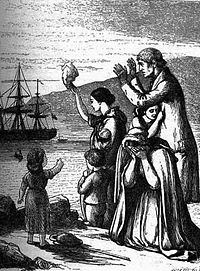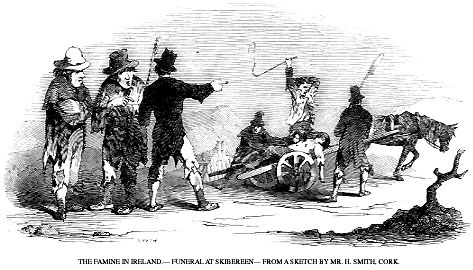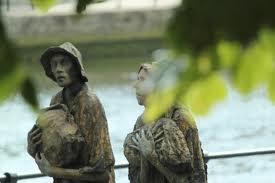The History of Potato and Corn
There are times when you have to take a rest from your gardening and think about the history of certain plants. For as long back as I can remember, my Grandmother talked to plants and to hear her tell it, they talked back -- maybe not in so many words but in how they struggled, survived, and in many cases thrived in her alliance with them. When she was in her nineties and mostly blind, she talked about what her plants had told her. One of my favorite stories was her ramblings about the history of corn and potatoes.
“I never plant potatoes unless I plant corn. I never serve potatoes, unless I serve corn. They are both a reminder of how history got rewrote and myths often begin.” Daisy Genevive Hohl-Owens
She was of course talking about the history of potatoes and the myths that surround the Great Irish Potato Famine. Sometimes, when you are out in a lovely garden it’s good to remember that behind every plant, bush, or tree – there is a history and usually some incorrect myth.
Potatoes and corn bound for Europe on Spanish ships - Art: by Jerilee Wei
How the Spaniards Brought
the Potato to Europe
Long before the Spaniards came to the New World, the potato had been cultivated by the Indians of the Chilean and Peruvian Andes. It is believed that the first potato was taken to Europe from Peru by the Spanish sometime during the early sixteenth century. From Spain, the plant seems to have spread to others parts of the Continent.
At first it was grown merely as a curiosity until the latter part of the eighteenth century. Others contend that Sir John Hawkins took the potato to England in 1565, but it seems likely that this was a sweet potato. A mathematician, Thomas Harriot, probably took the potato to English in 1585. He sailed on one of Sir Frances Drake's ships, so Drake is also said to have introduced the potato into England.
One fact is certain; Sir Walter Raleigh first grew potatoes in England and Ireland. Still, the tuber was not appreciated as a food then, or for many years thereafter in fact some believed it to be poisonous. A famous work on gardening, published in 1719, failed to even mention the potato. Some individuals, however, did recognize the value of the potato at an early date. In fact, the Royal Society of London recommended it as a possible safeguard against famine in Ireland. Possible famine had always been a reality among the poor in Ireland. The potato was grown more extensively in Ireland than in England. It became a staple in Ireland, and today we still call it the Irish Potato.
In France, the potato was not grown for food until after 1778, when Louis XVI saw a display of plants in bloom. The King, however, was less interested in the potatoes themselves, than in the flowers. The flower pleased him so much that he frequently picked one and put it in his buttonhole.
Great Irish Potato Famine - Scene at the workhouse
"The Almighty, indeed, sent the potato blight, but the English created the Famine."
-- John Mitchell
Corn Chowder
Corn and Potatoes -- Linked Together Forever In History
Where fact met myth began with the English strange laws having to do with corn. In the end, the potato would change the face of Ireland when over one million of its people died. Simultaneously, it would also change the face of America to include over one million more new immigrants, Even today, what happened is still a hotly debated issue both politically and historically. What little is taught about the Potato Famine, here in the United States, is very much minimized in some school texts. This is most likely a result of the English influence that our textbooks, particularly in the primary grades and through high school.
This was a time when the agricultural interests fore-ran all other forms of industry. It was before the heyday of American industrial revolution, when manufacturing and commercial interests lagged behind. In the New World, in the United States, agriculture was at a natural advantage that actually would aid later the industrial development. So it was encouraged and manufacturers were at a natural disadvantage. This largely had to do with attitudes of people and the government because of an exact reversal of policy in England.
Irish Potato Famine Families Immigrating to America
Corn Laws
It was fostered there and promoted from those places as centers by manufacturer's propaganda. It was finally forced, as a permanent policy on the British Parliament -- against the fiercest opposition of the landlord and country squires of the Nation. It's that struggle that brought about the Irish Potato famine. The whole problem was rooted in the Corn Laws, an old 1815 statue of 1670 that was reenacted by Parliament. Under the new law, the ports of England were absolutely closed against the importation of foreign grain. That is, such was the effect of the law. In some cases the price of what was raised to nearly five dollars a bushel. It is needless to say that the crowded people of the manufacturing towns cried out fiercely against such prices.
It was later only an amendment to the Corn Laws, by which a sliding scale, as it was called, was substituted for the Act of 1815, that the clamor of the starving populace was stilled for a season. The aim of the policy was to preserve and maintain a high price on English cereals, so that they might be produced, notwithstanding the disadvantages under which such production had been placed by nature and weather.
Great Irish Potato Famine mass exit of Ireland
From 1815 to 1841, it may be said that the Corn Laws were upheld both in theory and practice. Self interest was thought to be sub-served by such a law. Now, keep in mind that every member of the House of Lords was a large land-owner, and fully five-sixths of the members of the House of Commons were also in the same category. Parliament was a land-owning institution. It was virtually based on land-ownership.
Soon the manufacturers and artisans were pitted against the land-owning institutions. The manufacturing interests were largely unrepresented in Great Britain in the government body. Even if they were represented at all, it was believed because of their subordinated importance to the landed interests of the kingdom -- that their concerns were of little consequence.
Starving families in Ireland during potato famine - Artist: Mr. H. Smith, Cork - Public Domain
Greed In the Hearts of Manchester, Leeds, and Lancashire
By 1832, there were men who stepped in and launched a war of words against Corn Laws. The Anti-corn law League campaigned actively to reverse public opinion and substitute the principle of free trade, instead of the old protective system. Ten years later, that campaign of agitation moved from manufacturing town to manufacturing town. In the heart the storm that was brewing boiled over led by Richard Cobden. The year was 1838, when a commercial crisis occurred in the town of Bolton-le-Moors in Lancashire. Nearly all the business interests of the town and surrounding region, went to wreck. Three-fifths of the manufacturing businesses were shut down. More than five thousand working men were thrown out of employment, left homeless, and without the means of securing any other work.
The suffering families in manufacturing towns demanded grain and bread. This disaster was compounded when the same ruling class of landowners and government spread woes to include Ireland, with a little help from a natural disaster.
The summer of 1845 in Ireland was usually wet and cold. That kind of situation with a potato crop made it ripe for disease. A blight of rot attacked the young bulbs before maturity. By mid-summer, half the potato crop in Ireland was destroyed. Since the Irish population was dependant upon potatoes for subsistence, they had virtually nothing else to eat.
Their cry of hunger was to be heart across the channel. At first, the stories of famine growing in Ireland were not believed. Some in governmental control, just thought it was more agitators in the manufacturing political war starting rumors.
Grain was Britain's cash crop and their biggest export. Ireland had been excluded of the Corn Laws. The prices of grains were out of reach for the poor of Ireland. The rich land owners and they weren't backing down on the price. They would not send grain to the starving Irish.
Statues commerating Great Irish Potato Famine
The Great Irish Potato Famine Wasn't Caused by Blight
As a result, an Gorta Mór (the Irish potato famine) didn't just happen because of crop failure or blight. While this natural disaster played a small role, it was political and social issues that caused the Irish people to starve. The British could have helped but chose not to do so for strictly financial reasons. As a result, thousands of Irish fled for the New World, it was either that or starve. Some towns lost more than half their population to immigration. Still worse, was that it was the young and able fleeing.
The whole situation also had a lot to do with the struggle between the Catholics and the Protestants. Under British rule, Irish Catholics could not own or buy land. They had to rent their land or work on land that belonged to British Protestant landlords. Additionally, it was in part a "land grab" by the wealthy, as they took advantage of the situation and removed poorer tenants who could not pay their rent in mass evictions. Then, they could rent out the land in larger pieces, to remaining tenants who could afford to pay more.
The myth that the Great Irish Potato Famine still continues today as usually credible sources repeat the partial truth about a blight or potato disease being the true cause of the famine. One fact remains known by most people, by 19th, the potato was used in almost all civilized countries of the world and it’s a staple in many countries.







